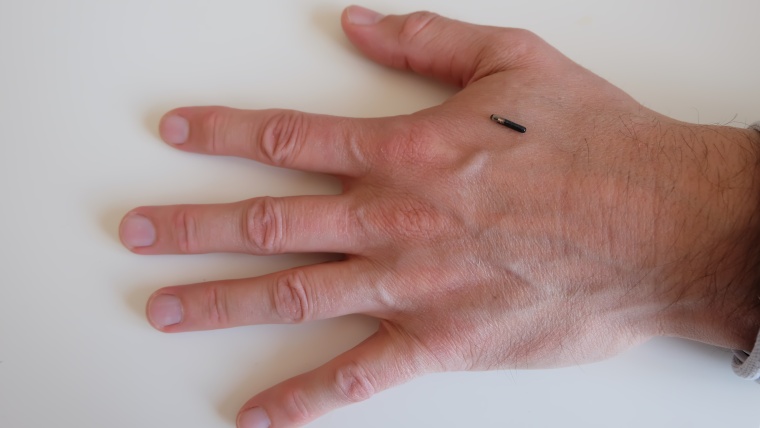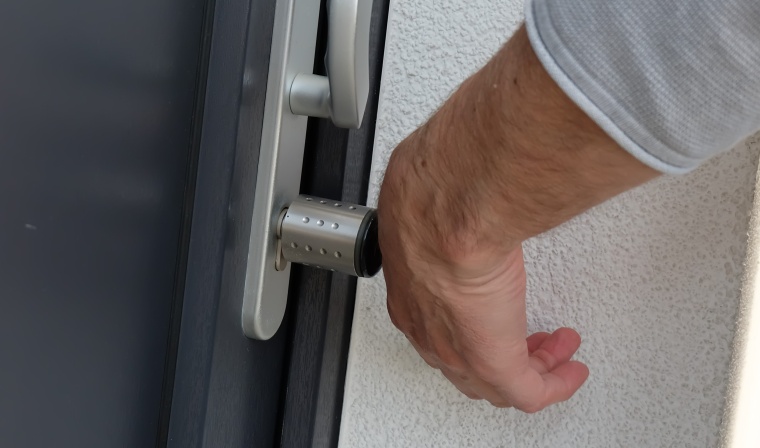Getting Under Your Skin with the Next Era of Access Control
Wilka's electronic lock cylinders are perfectly compatible with microchip implants to use for electronic access control.


It is pitch black, and a light drizzle has set in. A dark figure slowly approaches the door and stretches out its hand to the electronic lock cylinder – neither a key nor a transponder can be made out. Nonetheless, the knob of the electronic Wilka cylinder briefly glows green in the dark and the door opens as if by magic.
It sounds like science fiction, doesn’t it? “By no means,” says Dr. Patrick Kramer, founder and owner of Digiwell – Upgraded Humans, a platform for biohacking and human augmentation items. Kramer also sells electronic lock cylinders from Wilka, which he obtains from a nearby wholesaler, Bergedorfer Baubeschlag. In the case depicted, the cylinder is activated via a transponder chip in the hand. And that is where Wilka comes in, because electronic lock cylinders from the family company based in Velbert, Germany, are ideally suited to this type of opening, according to Dr. Kramer. “We tested a whole host of products. Those from Wilka react very sensitively due to their construction and can be opened at any time via the chip – even in the coldest winter through gloves.”
Digiwell stands for ‘digital wellness’ and describes itself as a specialist for microchip implants. It has the full variety of implantable technology solutions for people in its range – from RFID and NFC implants to customized systems and hardware installations. Its owner has been working with a major supplier of RFID implants, Dangerous Things, since 2014.
“Near-field technology is probably familiar to many people from their mobile phone or credit card. It is also referred to using the term ‘RFID tags’. These tags have a small amount of storage that can hold information, for example, emergency information, medical records, medication, key codes and contact information, marriage vows – but also links to websites like a Google photo album. The data can be transmitted wirelessly from this storage over a short distance, less than five millimeters,” explains Dr. Kramer. In principle, a human microchip implant is nothing other than an electronic RFID chip that is enclosed in biocompatible glass and works passively beneath the skin.
Function and Use of Microchip Implants
The first RFID implants were used twenty years ago, but they have enjoyed increasingly widespread use since around 2013. A microchip implant is passive, which means it works without its own power supply or battery and can be very easily configured individually via an app with a smartphone. The small chips are not capable of independent transmission, which means that it is not possible to track them. To be able to read data, an NFC-capable reader such as a smartphone has to be held at a short distance of one to four millimeters from the chip. Data transmission takes place simultaneously in encrypted form, which in turn guarantees protection against unauthorized data access.
There are diverse options for the use of NFC implants. They can be used as business cards and to store contact details, as access cards for locations such as gyms and offices, as openers for electronic lock cylinders, for cashless payment, for the storage of emergency medical information, as well as for the triggering of smart home applications or for the unlocking of password-protected computers. In the German-speaking region there are some 20,000 people who have such implants and so have a ‘digital interface’ in their body. Indeed, many people even have several chips under their skin so as to be able to use various functions or to cover different standards.
The microchip implants, of which there are two types, differ with respect to their technical RFID standards and their form. Just like there are Windows, Linux and Apple in the IT sector, there are various standards in the RFID area (for instance Ultralight, Classic, DesFire) in the high-frequency (13.56 MHz) and low-frequency (125 KHz) ranges. With respect to form factor, there are so-called ‘x-series implants’ and ‘flex implants’. The small x-series tags are placed directly beneath the skin using a syringe. This should always be carried out by a competent piercer or doctor. “Insertion is carried out in a few seconds, and it feels as if you have been pinched briefly,” says Dr. Kramer. The flat flex implants, by contrast, are placed beneath the skin by an experienced body modder (a special piercer) or doctor. This occurs under local anesthetic and takes just a few minutes. There are no injection complications, and they are never rejected by the body. The implants do not fuse with tissue and can be removed again at any time without any problems, if required.
Who Has Microchip Implants Fitted?
The majority of people who have microchips implanted are between the ages of thirty and fifty. Sixty percent are men, while forty percent are women. Their reasons differ: Some simply consider it fashionable, while others find that they mislay everything – including their house keys and car keys. The implanted chip renders this a thing of the past. For some people, though, implants represent added convenience, for example in the event of physical impediments. Dr. Kramer reports on two customers: the first is blind. The implanted chip makes it easier for her to access the changing room at the swimming pool, for instance, as her stick means she only ever has one hand free. Another customer, a 13-year-old girl, was born without arms. She has an implant in her foot and can now open the door of her home without any problems, as her father fitted a wall reader for the door at foot level. In both cases, the microchip offers greater quality of life and security. A basic implant can be acquired via Digiwell.com for just under 60 euros, which can then be used to open an electronic door at home.
Biohacking Partnership
When Dr. Kramer first demonstrated to Wilka that its electronic lock cylinders are perfectly compatible with microchip implants, he was delighted with the positivity and openness to this topic that he encountered in Velbert. A genuine partnership has now developed, even though the form of the collaboration is of course different to that with a ‘traditional’ dealer or locksmith. “It goes without saying that I have transformed myself into an expert on the electronic systems from Wilka in the years gone by. Now, if customers enquire about an ‘electronic door lock’, I can provide them with extensive product advice and explain why this is so easy with these particular cylinders,” says Kramer. The biohacker sells the cylinders in a special edition. Naturally, an after-sales service in relation to the cylinders is also part of his offer. And should a customer ultimately decide against the implant – the electronic Wilka lock cylinder can also be acquired from Digiwell in traditional fashion, for instance with a transponder for a key chain.
© All Images: Wilka Schließtechnik


Business Partner
Wilka Schließtechnik GmbHMettmanner Str. 56-64
42549 Velbert
Germany
most read

Security management, building security & perimeter protection: the winners of category E at the GIT SECURITY AWARD 2026
GIT SECURITY AWARD 2026: Security management, building security & perimeter protection - an overview of the most innovative solutions


Integrated and Futureproof: Traka’s Next Chapter
Interview with Stefni Oliver on Traka’s Vision for the Future

When the Internet stumbles: Why DNS is important
When DNS fails, the internet stumbles-AWS outage proves resilience and redundancy are vital for digital trust

Machine & plant safety: The winners of category A at the GIT SECURITY AWARD 2026
GIT SECURITY AWARD 2026: Machine & plant safety - an overview of the most innovative solutions








